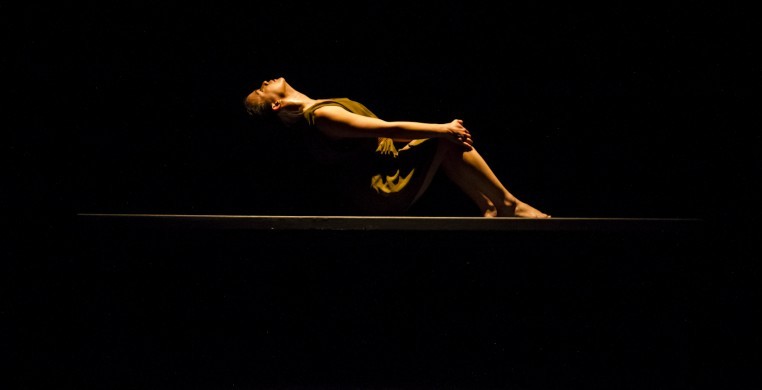The third installment of “Vision, Faith, & Desire: Dancemakers Inspired by Martha Graham” is a site-specific experiment with noble aspirations. Co-produced by Winifred Haun & Dancers and the Pleasant Home Foundation, the program featured work by six choreographers performed simultaneously in different rooms of Historic Pleasant Home in Oak Park. Audience members, divided into groups, rotated from room to room to view each piece.
The Historic Pleasant Home is a slumbering Leviathan, a bygone guardian of its stately Oak Park neighborhood. Built in 1897 by George W. Maher, a pioneer of modernity in his day, Pleasant Home is one of the country’s foremost examples of the The Prairie School of architecture that signaled a new aesthetic in American domestic life.
Martha Graham was a pioneer of a new aesthetic in dance theater. Beginning in the 1930’s and continuing on through the late 20th Century, Graham’s bold exploration of psychological drama, and the codification of a dance technique tailored to express it, revolutionized American concert dance.
Combining the two must have seemed like a logical coupling to Oak Park-based choreographer Winifred Haun, herself trained in the Graham technique, but signs of Graham’s influence made only sporadic appearances throughout the seven pieces by Haun, Randy Duncan, Yuriko, Alex Springer and Xan Burley, and Michael Estanich.
Site-specific performance comes with possibilities, challenges, and limitations. The question becomes whether or not the unconventional setting enhances the artistic impact of the dancing and choreography. Inserting public performance of any kind into a domestic environment as intimate as Historic Pleasant Home needs to be handled with optimum care to integrate performance with environment. In the case of “Vision, Faith & Desire III,” the experiment had mixed results.
Bach cello suites, beautifully played by Sophie Weber, made for a gracious introduction to the event as well as a transitional signal for audience movement between rooms. The deeply resonant tones of the cello and the soulful Bach music integrated sound with the dark stone and carved wood of the elegant Living Room/Dining Room, arranged in conventional audience/stage configuration with rows of seating. Dancing sometimes appeared an almost jarring intrusion, as with Haun’s excerpt from Promise (2009), which opened the program to proscenium-style staging. Costumes suggested a period aura with the women in long white skirts and high-collared blouses and the men in slacks and vests. A sprinkling of Graham vocabulary added a primitive simplicity to gestures and group spatial patterns. Haun’s dancers performed with clean, competent student-level execution.
Former Graham dancer Yuriko’s The Cry (1963) reflected the Graham imprint with mimetic clarity, utilizing the central impulse of contraction and release to construct a classically Grahamesque psychological portrait. Performed with restrained emotional nuance and exquisite articulation of Graham technique by Deborah Goodman, a former student of Yuriko’s, the intimacy and curved lines of the piece made sense in the small Semi-Circular Porch space.
In The Library, we found ourselves watching Alex Springer and Xan Burley’s dance film, Mare (2014). Filmed in a forest and meadow, there was no apparent reason for its inclusion in this collection. The performers, all rank amateurs or non-dancers, were dressed in work boots and hillbilly frocks and variously ran, fell, twisted, and turned in minimalist patterns to minimal effect or interest.
Homeland (2013), a duet by Michael Estanich, was so up close and personal in the tiny Summer Dining Porch that audience members were literally cheek to cheek with performers, deliberately violating the separation of audience and performer and yet not utilizing that breach to artistic advantage. The dancers looked out windows, stepped out the door, and pondered the mosaic flooring without sufficiently developing movement material. In addition to spatial constraints, student-level dance composition and execution were also problematic here.
Randy Duncan’s Love Not Me (1989) gave dancer Sarah Robinson a character portrait of a woman possessed. The huge range of motion confined to the area of a chair was well-suited to the intimacy of the Great Room but otherwise made no specific connection to the space.
Haun’s Lamentation Variation (premiere), a trio performed in the same room, was the only piece created specifically for Pleasant Home and deliberately designed to respond to a specific Graham work, her revolutionary solo, Lamentation (1930). The first half of the piece echoed Graham’s movement motif of core impulses with the three dancers seated on stools. Part two set them moving in a rock-music protest of mock angst.
The event culminated with the full audience back in the Living Room for Haun’s Don’t Linger Too Long (2013). On second viewing (it was first staged at the Ruth Page Theater) the piece suffered in the space from lack of theatrical lighting and spatial vista that a proscenium stage could provide.
Moving from room to room for each piece and dwelling inside the magic of Pleasant Home provided a delightful alternative that begged for creative adaptations the choreographers might have achieved to accommodate their work to the uniqueness of Pleasant Home.
Lynn Colburn Shapiro
April 20, 2014

